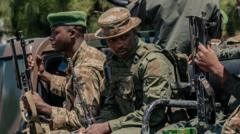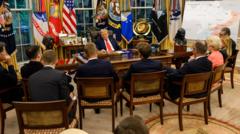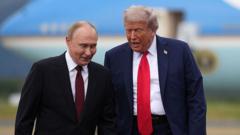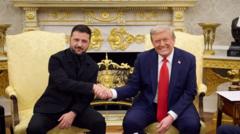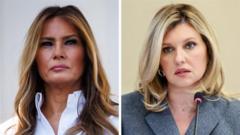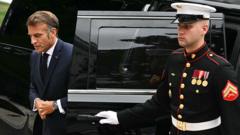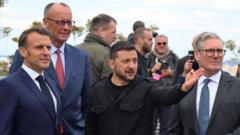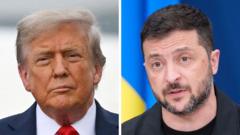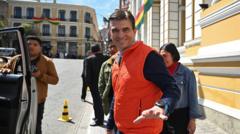In a landscape filled with challenges, President Trump struggles to maintain momentum toward peace in Ukraine as critical dialogues yield limited results.
Pressure Mounts on Trump as Diplomatic Hurdles Continue in Ukraine Conflict
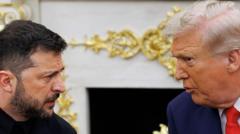
Pressure Mounts on Trump as Diplomatic Hurdles Continue in Ukraine Conflict
Trump faces growing scrutiny as Ukraine negotiations stall following his recent summit with Putin.
Last Friday, Donald Trump and Vladimir Putin convened in Alaska, where their summit, while visually spectacular, fell short of delivering significant diplomatic advancements aimed at resolving the ongoing Russia-Ukraine conflict. Following the meeting, six European leaders rushed to Washington DC on Monday to confer with Trump about the implications of the summit and to evaluate possible pathways forward. However, this historic meeting produced more rhetoric than actionable outcomes, putting increased pressure on a president who had vowed to conclude foreign wars during his campaign.
Despite minimal progress from the two contentious summits, there were some notable developments. During the White House meeting, Trump expressed a willingness to offer U.S. security assurances for Ukraine contingent on an agreement, something seen as essential by both Ukrainians and their European partners for establishing lasting peace. However, on Tuesday morning, he tempered that enthusiasm, clarifying that U.S. commitments could involve "air support" rather than boots on the ground, suggesting that European nations would need to shoulder a significant part of the responsibility.
Trump also alluded to "arrangements" for a potential bilateral summit between Putin and Zelensky, though specifics remain uncertain. European leaders are advocating for a ceasefire prior to any direct discussions, which Trump indicated is unlikely. Nevertheless, the mere fact that Trump, Zelensky, and European allies could engage in cooperative dialogue marks a shift from past contentious engagements, especially compared to Zelensky’s earlier White House visit in February and Trump's typically strained interactions with his European counterparts.
In interviews, Trump seemed to embrace his role as a mediator, noting that he believes achieving peace would contribute significantly to his legacy. Nonetheless, the challenges to peace remain daunting, particularly given the uncertainty surrounding Putin's intentions, who appears to be making incremental gains on the battlefield.
Concerns linger that Putin might delay negotiations while navigating potential sanctions, which Trump recently put on hold. His conviction that Putin seeks an agreement has sparked skepticism, especially considering Putin's continued military actions in Ukraine over nearly four years. Over time, Trump's relationship with Zelensky has fluctuated, complicating perceptions of Trump as a reliable partner in these negotiations.
Moreover, European leaders have readily acknowledged their apprehensions about Trump’s unpredictable foreign policy. Finnish President Alexander Stubb remarked that recent diplomatic efforts may represent more movement toward peace than in years past. The swift arrangement of the European visit to Washington appeared aimed at presenting a united front to counteract any Russian influence on Trump’s perspectives.
But Trump’s decision-making is not solely swayed by geopolitical elements; his political base's "America First" stance complicates any military engagements abroad. His supporters may view any commitment of military resources to Ukraine as unfavorable, especially amid rising domestic priorities.
Ultimately, despite Trump's aspirations of being perceived as a peacemaker, his stake in the negotiations pales in comparison to those of Europe, Russia, or Ukraine. As a result, Trump retains the option to exit the negotiations, a potential power move that could alter the trajectory of U.S. involvement in the peace process moving forward.

